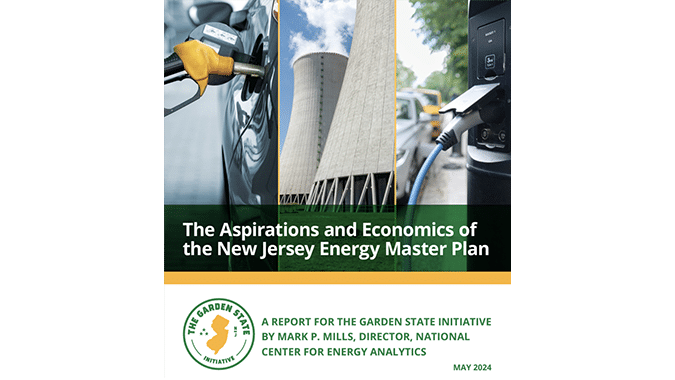A report released at The Garden State Initiative’s Annual Policy Forum in New Brunswick on Thursday concludes that New Jersey’s Energy Master Plan, which mandates 100% clean energy by 2035 is unrealistic and the cost to implement it would cost an estimated $40 billion.
The research was done by energy policy expert Mark P. Mills, director of the National Center for Energy Analytics, for The Garden State Initiative, a research and education nonprofit that advocates for policy solutions that spur economic growth.
Mills is also a distinguished senior fellow at the Texas Public Policy Foundation, faculty fellow at Northwestern University’s McCormick School of Engineering and Applied Science, and contributing editor at City Journal, a magazine founded by the Manhattan Institute.
The report, “Aspirations and Economics of the New Jersey Energy Master Plan,” was released at GSI’s Annual Policy Forum, attended by 125 academics, legislators, journalists, and other policy stakeholders from around the state.
“Governor Murphy’s mandate that New Jersey attain 100 percent clean energy by 2035 is a laudable goal, but it’s not realistic,” said GSI President Audrey Lane. “The bottom line is that the goals set forth in the NJ EMP are purely aspirational and our report painstakingly makes that clear. The unrealistic nature of implementing this plan doesn’t even take into account the price tag, which we estimate at a whopping $40 billion, and would drive even more people and jobs out of the state.”
In the report, Mills raises pointed questions about whether New Jersey can produce the electricity it needs relying almost entirely on wind and solar technologies in time to meet the 2035 mandate – and whether doing so would have the desired outcome of reducing the state’s contribution to global CO2 emissions.
Given that New Jersey currently obtains over 90% of all the state’s energy from hydrocarbons, 98% of vehicles on the roads use petroleum, and 85% of the state’s residential homes and commercial buildings are heated with natural gas or propane fuel, reducing those metrics to zero in just over 10 years will have enormous economic and social consequences, Mills said. This would punish New Jerseyans who are least able to afford higher energy costs and create disincentives for industries and businesses to locate or remain in the state, he said.
Mills analyzed the Energy Master Plan’s ‘seven strategies’ to move away from hydrocarbons and offered these perspectives.
- EMP Strategy #1: Reducing Energy Consumption and Emissions in Transportation. Reality: “Total life cycle analyses point to small, possibly non-existent reductions in CO2 emissions associated with mass deployment of EVs,” the report states.
- EMP Strategy #2: Accelerating Deployment of Renewable Energy and Distributed Energy Resources. Reality: “Greater deployment of wind and solar correlates, everywhere, with increased cost of electricity,” the report states.
- EMP Strategy #3: Energy Efficiency and Conservation to Reduce Peak Demand. Reality: “In an unrestricted economy, in nearly all applications, increased energy efficiency is associated with an overall net increase in energy demand.”
- EMP Strategy #4: Reduce Building Energy Use. Reality: “The future potential for energy savings is now far less and will take more time and cost more than in the past,” the report states.
- EMP Strategy #5: Decarbonizing and Modernizing New Jersey’s Energy System. Reality: “The track record for ‘decarbonizing’ energy systems shows very small changes in overall societal carbon-intensity, and far higher consumer costs,” the report states.
- EMP Strategy #6: Community Energy Planning and Action in Underserved Communities. Reality: “Policymakers should keep in mind a basic tenet for low-income citizens and communities, i.e., high energy costs are destructive,” the report states.
- EMP Strategy #7: Expand the Clean Energy Innovation Economy. Reality: “Many proposed ‘clean energy’ innovation policies are antithetical to other innovation policies and objectives,” the report states.
GSI’s Lane said the report “provides a reality check on aspirational policy.”
“New Jersey residents, taxpayers, and business owners need to understand how state policies will affect them now and, in the future,” Lane said. “We see this report as part of fulfilling that part of our mission and stoking a more honest and robust debate about the future of energy in the state.”

